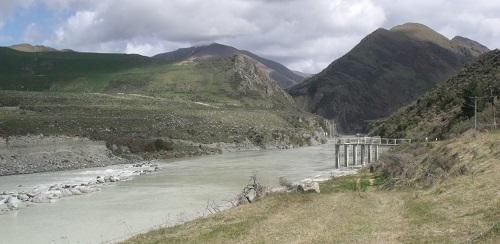On Thursday October 8th, 24 members of the Natural History group went on a trip to the Mid Canterbury Irrigation.
We were accompanied by Hamish Tait, the General Manager of Mayfield Hinds Irrigation Ltd, who was ably assisted by two of our members – Terry Heiler and Alan Stevens. A comprehensive viewing of many parts of the scheme;- the intake from the Rangitata River, (including the trout diversion race), border dykes, the very large Carew storage ponds (I will never know how they laid the liners in Canterbury winds), the farmers’ turbines, and smaller power schemes generating electricity to help run pumps on farms, the technology which automatically regulates the canal flows by remote adjustment, and the number of large pivot irrigators, the increase in soil depth on the lighter Lismore Gravels, due to increased grass root growth, and so much more.

The Rangitata Diversion Race (RDR) intake. The stone wall in the Rangitata river diverts water to the intake (under the concrete columns. The water travels along a concrete tunnel (just visible) to the start of the RDR. The stone wall must be rebuilt after heavy rain and flooding. The amount of water that may be taken depends on the river flow, which is monitored by Environment Canterbury. The maximum take is 16.8 cumecs (cubic metres per second).

Start of the Rangitata Diversion Race (RDR). This is the end of the concrete tunnel from the river intake.

The fish diverter at the start of the RDR. A pipe with holes is laid diagonally in the race. Air bubbles and sound generated by a vibrating membrane guide the fish to a small diversion race that diverts a small portion of the water back to the Rangitata carrying the fish. You can see the row of bubbles from the centre-left of the picture.

RDR sand trap. A bend and widening in the race causes the water to slow and drop much of the sand in the bend. Every day or so the sluice gate (visible top-right) is opened to flush the sand back to the Rangitata. Less the sand in the water means less wear on pumps and the power station that use the water.

Parts of the RDR fall relatively steeply. The scheme has an overall fall of 300m. A series of weirs remove the energy from the water to reduce scouring. This weir automatically controls the water flow by adjusting gates based on the water level measured downstream.

Two of the Carew farm storage ponds. Three ponds, covering an area of 150ha, store up to 6.1 million cubic metres (61,000,000,000 litres). It increases the reliability of the Mayfield Hinds Irrigation Scheme by supplying water when water taken from the Rangitata has to be reduced. The entire area of the ponds is lined with HDPE plastic that is welded into a continuous sheet.
Some key facts of the Mayfield Hinds Irrigation Scheme
- Delivers up to 16.8 cumecs from the Rangitira Diversion race (RDR)
- It is the largest privately-owned scheme in NZ serving 36,000 hectares
- The RDR is a 67km canal delivering water to 4 irrigation schemes with hydro-generation at Montalto and Highbank. Three of the schemes are:
- Mayfield/Hinds scheme between the Rangitata and Hinds rivers
- Valetta scheme between the Hinds and Ashurton rivers
- Ashburton/Lyndhurst scheme between the Ashburton and Raikaia rivers
- First water was delivered to the scheme in 1947
- The scheme was purchased from the government in 1990 and is now a co-operative company
- Today 90% of the land is spray irrigated and variable flows are delivered to on-farm ponds
- 3.5mm/day allocation is subject to river restrictions in the season 10 September to 9 May
- 320km of open channels with a fall of 300m across the scheme
- The scheme is continuing to modernise with telemetry and automation
- There are 140 farm ponds averaging 40,000 m3 capacity.


